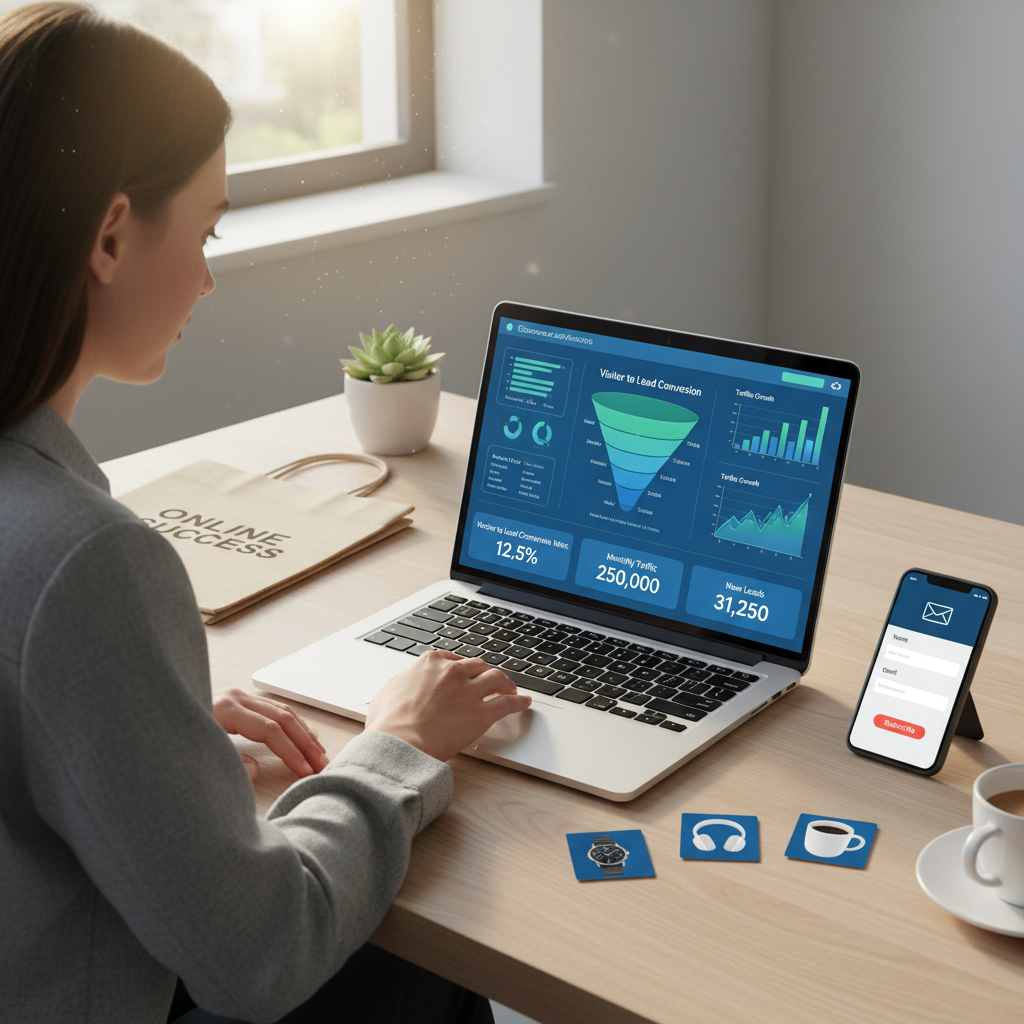Learn how Fortune 500 brands are using identity resolution in 2025












Comprehensive data analysis revealing industry benchmarks, optimization strategies, and first-party data collection tactics that transform anonymous traffic into owned customer relationships
Typical eCommerce sales conversion rates are roughly 1-3%, meaning the vast majority of visitors don't convert on the first visit. Yet the stores that master visitor-to-lead conversion through strategic email capture and identity resolution achieve conversion rates 4-5x higher than industry averages. The gap between top performers and average stores isn't luck—it's a systematic approach to identifying high-intent shoppers and converting them into owned, retargetable leads before they disappear forever.
Multiple authoritative sources converge on a 2.5-3% global average for eCommerce conversion rates in 2024-2025, though individual studies report ranges from 1.65% to 3.65% depending on methodology. This baseline establishes that 96-98% of visitors leave without taking any conversion action, highlighting the massive opportunity for stores that implement systematic lead capture strategies.
Consumable goods categories demonstrate 4.6-4.9% conversion rates, reflecting lower purchase friction and natural replenishment cycles. The recurring nature of food purchases makes email capture especially valuable, as a single lead can generate multiple purchases over time through strategic email marketing.
High-ticket luxury items face the lowest conversion rates at 0.9-1%, driven by extended research periods and significant purchase consideration. For luxury brands, lead capture becomes essential since the sales cycle extends across weeks or months, requiring ongoing nurture through email and retargeting to stay top-of-mind.
Business-to-business eCommerce experiences 1-2.5% conversion rates, reflecting committee-based purchasing, longer evaluation periods, and higher average order values. B2B email capture is particularly critical as it enables account-based nurturing and multi-stakeholder engagement throughout extended decision processes.
Despite mobile's traffic dominance, desktop outperforms mobile by 65% in conversion rates (4.8% vs 2.9%). This dramatic gap persists even as mobile becomes the primary browsing device, creating a critical optimization opportunity for stores that can close the mobile conversion deficit.
Mobile devices now command 59.6% of traffic, yet consistently underperform desktop in conversion metrics. This traffic-conversion mismatch means mobile optimization isn't optional—it's the highest-leverage improvement opportunity for most eCommerce stores.
The mobile experience drives 83.1% cart abandonment versus desktop's already-high 67%. This 16-point gap represents the friction cost of small screens, difficult typing, and slower connections. Email capture before cart abandonment enables recovery of these mobile abandoners through less friction-heavy channels.
According to Wisepops customer data, strategic website popups achieve 4.65% average conversion rates—significantly higher than the 1.65-3.65% site-wide conversion average. This performance validates popups as a high-return lead capture mechanism when implemented correctly with appropriate timing and value propositions.
Wisepops data shows the highest-performing popup implementations achieve 19.77% conversion rates—nearly 6x the industry average. This dramatic range between average and top performers reveals that popup quality, targeting, and offer strength matter far more than the popup mechanism itself.
Wisepops data shows offering valuable lead magnets doubles mobile conversion rates from 3.83% to 7.73%. The value exchange—premium content, discounts, or exclusive access in return for an email—overcomes mobile friction and provides clear motivation for the opt-in action.
On desktop, Wisepops data indicates lead magnets boost conversion from 1.84% to 4.7%—a 155% improvement. This consistent impact across devices validates the value-exchange model as the most effective lead capture approach regardless of visitor context or device type.
While email generates 2.6% average conversion across all campaigns, this baseline masks the dramatic performance variation between generic broadcasts and targeted, behavioral sequences. Generic promotional emails convert far below this average while abandoned cart and browse abandonment flows convert far above.
Highly segmented, behavior-triggered email campaigns reach conversion rates up to 28.6%—more than 10x the email average. This extraordinary performance demonstrates the power of personalization, timing, and relevance in email marketing strategies.
Cart abandonment emails generate 40-50% open rates—double typical marketing email performance. The personal relevance and timely delivery drive exceptional engagement, making abandoned cart sequences the highest-performing automated flow for most eCommerce brands.
Direct website visits achieve 3.3% conversion rates, outperforming all other channels. This superior performance reflects high purchase intent and brand familiarity, making direct traffic protection through email list building essential as third-party attribution deteriorates.
Organic search traffic delivers 2.7% conversion versus social media's 1.5%, reflecting higher purchase intent and problem-aware mindset. This performance gap validates SEO investment and highlights the challenge of converting social traffic without extended nurture.
Social media generates the lowest rate at 1.5%, driven by interruption-based discovery rather than active search. For social traffic, email capture becomes critical to enable nurturing cold prospects into purchase-ready customers through ongoing engagement.
Harvard Business Research research shows that responding to leads within 5 minutes dramatically increases the odds of qualifying and connecting with prospects compared to slower follow-up. This impact makes real-time lead routing and automated immediate response essential for maximizing lead capture ROI.
According to Wisepops data, timing popup displays to appear after one page view can generate conversion rates as high as 28.98%—far higher than immediate display. This delay allows visitors to assess site quality and build initial trust before being asked for contact information.
Wisepops data suggests strategic timing of popups 5-15 seconds after page load optimizes the balance between giving visitors orientation time and capturing attention before exit. Too early triggers annoyance; too late misses the engagement window.
Wisepops data shows minimalist single-field forms achieve 5.77% conversion, dramatically outperforming longer alternatives. Requesting only email addresses removes decision friction and reduces completion time, maximizing opt-in likelihood.
Traditional contact forms on websites achieve only 1.7% conversion on average—far below popup and strategic opt-in performance. This low baseline reflects poor visibility, weak value propositions, and high friction in most form implementations.
Companies implementing AI-powered personalization report 10-15% revenue increases, with advanced implementations achieving higher gains. AI-powered segmentation enables precision targeting that generic approaches cannot match.
According to Salesforce research, 66% of customers expect companies to understand their unique needs, yet only 34% believe brands deliver this experience. Closing this expectation gap through personalized email capture and follow-up separates top performers from average competitors.
The cross-device journey complicates attribution as many customers research on one device and purchase on another. Cross-device identity ensures you can track and nurture the complete customer journey regardless of device switching.
iOS 14.5 privacy changes and cookie deprecation have driven direct traffic to 20% of overall traffic, masking true source attribution. First-party email data becomes the only reliable way to understand customer origins and track conversion paths.
Attribution complexity has reached the point where 40% of leaders cannot accurately measure social media impact on business results. This measurement crisis makes first-party data collection through email capture essential for maintaining marketing accountability.
The deprecation of third-party cookies and increasing privacy regulations make first-party data ownership non-negotiable for sustainable eCommerce growth. Stores that build robust email lists through strategic visitor identification own their customer relationships and marketing channels, while those dependent on rented traffic face increasing costs and decreasing effectiveness.
According to the company, Opensend Connect enables stores to identify high-intent visitors in real time and convert them into owned leads before they leave. The platform is designed to comply with applicable data privacy laws including GDPR and CCPA, transforming anonymous traffic into actionable first-party data through legal, consent-based methods.
Successful lead capture programs combine multiple strategies:
Email list building represents the foundation of owned audience development. Every captured email compounds in value through ongoing engagement, repeat purchases, and referral opportunities.
Beyond conversion rate percentages, successful programs track:
Opensend Revive addresses email list decay by automatically replacing bounced addresses with active emails for the same users, preventing the 20-30% annual list degradation most brands experience.
A good visitor-to-lead conversion rate ranges from 3-5% for most eCommerce stores, though top performers achieve 7-10%+ through strategic optimization. Performance varies significantly by industry—personal care brands naturally convert higher (5-7%) while luxury goods face lower baselines (2-3%). The key benchmark is whether your rate exceeds your industry average and shows improvement over time through testing.
Lead conversion rate measures the percentage of visitors who provide contact information (typically email), while sales conversion rate measures the percentage who complete purchases. Lead conversion typically runs 2-3x higher than sales conversion since capturing an email requires lower commitment than making a purchase. Both metrics are critical—high lead capture without sales conversion indicates nurturing problems.
Personal care and beauty products achieve the highest rates at 6.8%, followed by food and beverage at 4.6-4.9%. These consumable categories benefit from emotional purchase drivers, lower price points, and repeat buying behavior. In contrast, luxury goods and high-ticket items convert at just 0.9-1% due to extended consideration periods and higher purchase risk.
Modern identity resolution uses proprietary databases and consent-based partner networks to identify visitors without cookies. According to the company, Opensend's platform matches visitors through legal, compliant methods including cross-site identity graphs and first-party data partnerships. This cookie-less approach remains effective as browsers deprecate third-party cookies.
High-performing lead capture programs combine multiple tools: strategic popup software (Wisepops, OptiMonk), identity platforms like Opensend Connect, email providers (Klaviyo, Attentive), and AI-powered segmentation for targeting. The most effective approach integrates these tools to capture leads across the customer journey, from initial visit through cart abandonment to post-purchase retention.







